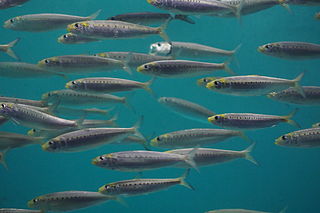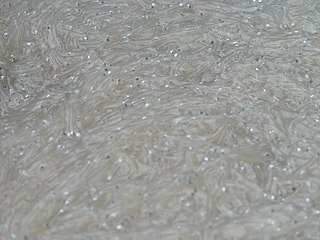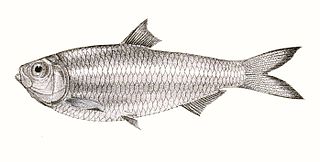
The mahi-mahi or common dolphinfish is a surface-dwelling ray-finned fish found in off-shore temperate, tropical, and subtropical waters worldwide. Also widely called dorado and dolphin, it is one of two members of the family Coryphaenidae, the other being the pompano dolphinfish. These fish are most commonly found in the waters around the Gulf of Mexico, Costa Rica, Hawaii and the Indian Ocean.

The brown pelican is a bird of the pelican family, Pelecanidae, one of three species found in the Americas and one of two that feed by diving into water. It is found on the Atlantic Coast from New Jersey to the mouth of the Amazon River, and along the Pacific Coast from British Columbia to northern Chile, including the Galapagos Islands. The nominate subspecies in its breeding plumage has a white head with a yellowish wash on the crown. The nape and neck are dark maroon–brown. The upper sides of the neck have white lines along the base of the gular pouch, and the lower fore neck has a pale yellowish patch. The male and female are similar, but the female is slightly smaller. The nonbreeding adult has a white head and neck. The pink skin around the eyes becomes dull and gray in the nonbreeding season. It lacks any red hue, and the pouch is strongly olivaceous ochre-tinged and the legs are olivaceous gray to blackish-gray.

"Sardine" and "pilchard" are common names for various species of small, oily forage fish in the herring family Clupeidae. The term "sardine" was first used in English during the early 15th century; a folk etymology says it comes from the Italian island of Sardinia, around which sardines were once supposedly abundant.

Sprat is the common name applied to a group of forage fish belonging to the genus Sprattus in the family Clupeidae. The term also is applied to a number of other small sprat-like forage fish. Like most forage fishes, sprats are highly active, small, oily fish. They travel in large schools with other fish and swim continuously throughout the day.

Knightia is an extinct genus of clupeid bony fish that lived in the freshwater lakes and rivers of North America and Asia during the Eocene epoch. The genus was erected by David Starr Jordan in 1907, in honor of the late University of Wyoming professor Wilbur Clinton Knight, "an indefatigable student of the paleontology of the Rocky Mountains." It is the official state fossil of Wyoming, and the most commonly excavated fossil fish in the world.

The ciscoes are salmonid fish that differ from other members of the genus in having upper and lower jaws of approximately equal length and high gill raker counts. These species have been the focus of much study recently, as researchers have sought to determine the relationships among species that appear to have evolved very recently. The term cisco is also specifically used of the North American species Coregonus artedi, also known as lake herring.

The school shark is a houndshark of the family Triakidae, and the only member of the genus Galeorhinus. Common names also include tope, tope shark, snapper shark, and soupfin shark. It is found worldwide in temperate seas at depths down to about 800 m (2,600 ft). It can grow to nearly 2 m long. It feeds both in midwater and near the seabed, and its reproduction is ovoviviparous. This shark is caught in fisheries for its flesh, its fins, and its liver, which has a very high vitamin A content. The IUCN has classified this species as critically endangered in its Red List of Threatened Species.

Sardinops is a monotypic genus of sardines of the family Clupeidae. The only member of the genus is Sardinops sagax. It is found in the Indo-Pacific and East Pacific oceans. Its length is up to 40 cm (16 in). It has numerous common or vernacular names, some of which more appropriately refer to subspecies, including blue pilchard, Australian pilchard, blue-bait, Californian pilchard, Peruvian Pacific sardine, South American pilchard, Chilean sardine, Japanese pilchard, Pacific sardine, and Southern African pilchard.
Chelaethiops is a genus of cyprinid fish found in lakes and rivers of Africa. While commonly called "sardines", they are not related to the true sardines of the family Clupeidae. There are currently five recognized species in this genus.

Whitebait is a collective term for the immature fry of fish, typically between 25 and 50 millimetres long. Such young fish often travel together in schools along coasts, and move into estuaries and sometimes up rivers where they can be easily caught using fine-meshed fishing nets. Whitebaiting is the activity of catching whitebait.

The white sardinella, also known as deep-bodied sardine, perforated-scale sardine or short-bodied sardine, is a species of ray-finned fish in the genus Sardinella. It is an important food fish, which can be feed as dried, salted, or fresh forms.

The Indian oil sardine is a species of ray-finned fish in the genus Sardinella. It is one of the two most important commercial fishes in India. The Indian oil sardine is one of the more regionally limited species of Sardinella and can be found in the northern regions of the Indian Ocean. These fish feed on phytoplankton (diatoms) and zooplankton (copepods).

A bait ball, or baitball, occurs when small fish swarm in a tightly packed spherical formation about a common centre. It is a last-ditch defensive measure adopted by small schooling fish when they are threatened by predators. Small schooling fish are eaten by many types of predators, and for this reason they are called bait fish or forage fish.

The European pilchard is a species of ray-finned fish in the monotypic genus Sardina. The young of the species are among the many fish that are sometimes called sardines. This common species is found in the northeast Atlantic, the Mediterranean, and the Black Sea at depths of 10–100 m (33–328 ft). It reaches up to 27.5 cm (10.8 in) in length and mostly feeds on planktonic crustaceans. This schooling species is a batch spawner where each female lays 50,000–60,000 eggs.

Sardines ("pilchards") are a nutrient-rich, small, oily fish widely consumed by humans and as forage fish by larger fish species, seabirds and marine mammals. Sardines are a source of omega-3 fatty acids. Sardines are often served in cans, but can also be eaten grilled, pickled, or smoked when fresh.
The slender white sardine is a species of sardine in the genus Escualosa. It was described by Thosaporn Wongratana in 1983. It is a tropical fish which was discovered at a Sunday market in Bangkok, Thailand, though the two specimens were caught off the eastern coast of the Gulf of Thailand. The sardines are known to swim at a maximum depth of 50 metres. The largest known standard length for the species is 6.7 centimetres. It is distinguished from its sister species, Escualosa thoracata by having a slenderer body, earning it its common name, and also by a silver band on its flank.

Sardinella tawilis is a freshwater sardine found exclusively in the Philippines. It is the only member of the genus Sardinella known to exist entirely in fresh water. Locally, they are known in Filipino as tawilis.

The Alosidae, or the shads, are a family of fishes. The family comprises seven genera worldwide, and about 30 species.

The white sardine is a species of fish in the family Clupeidae. It was described by Achille Valenciennes in 1847. It is a tropical fish of the Indo-Pacific distributed from Thailand to Indonesia and Australia. Other common names include deep herring and northern herring.

The Bloch's gizzard shad, also known as gizzard shad, hairback, long-finned gizzard shad, long-ray bony bream and thread-finned gizzard shad, are a widespread and common, small to medium-sized anadromous fish found in all marine, freshwater and brackish waters throughout Indo-West Pacific, towards eastward of Andaman Sea, South China Sea and the Philippines to Korean peninsula. Single specimen recorded from waters of South Africa. It was described by Marcus Elieser Bloch in 1795.


















